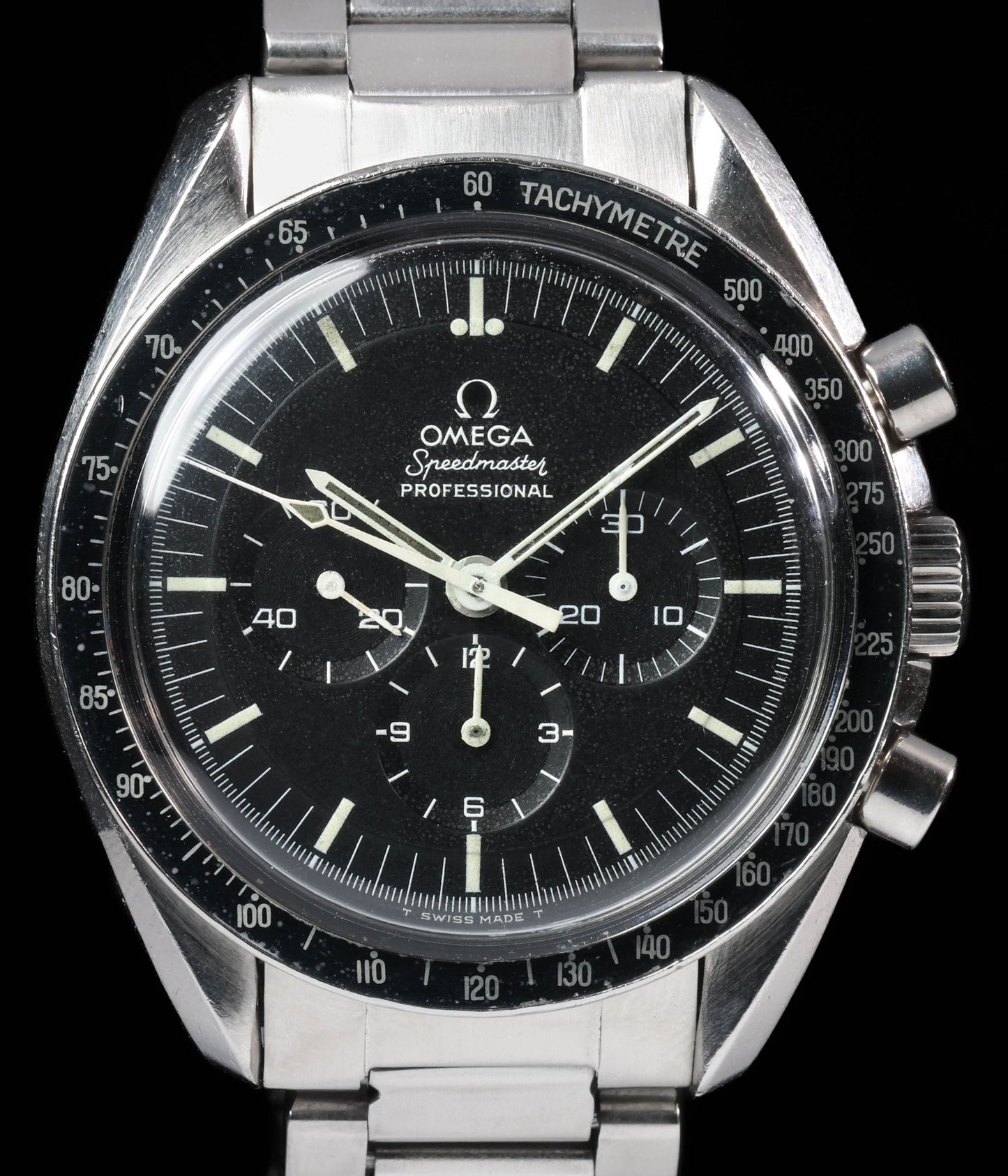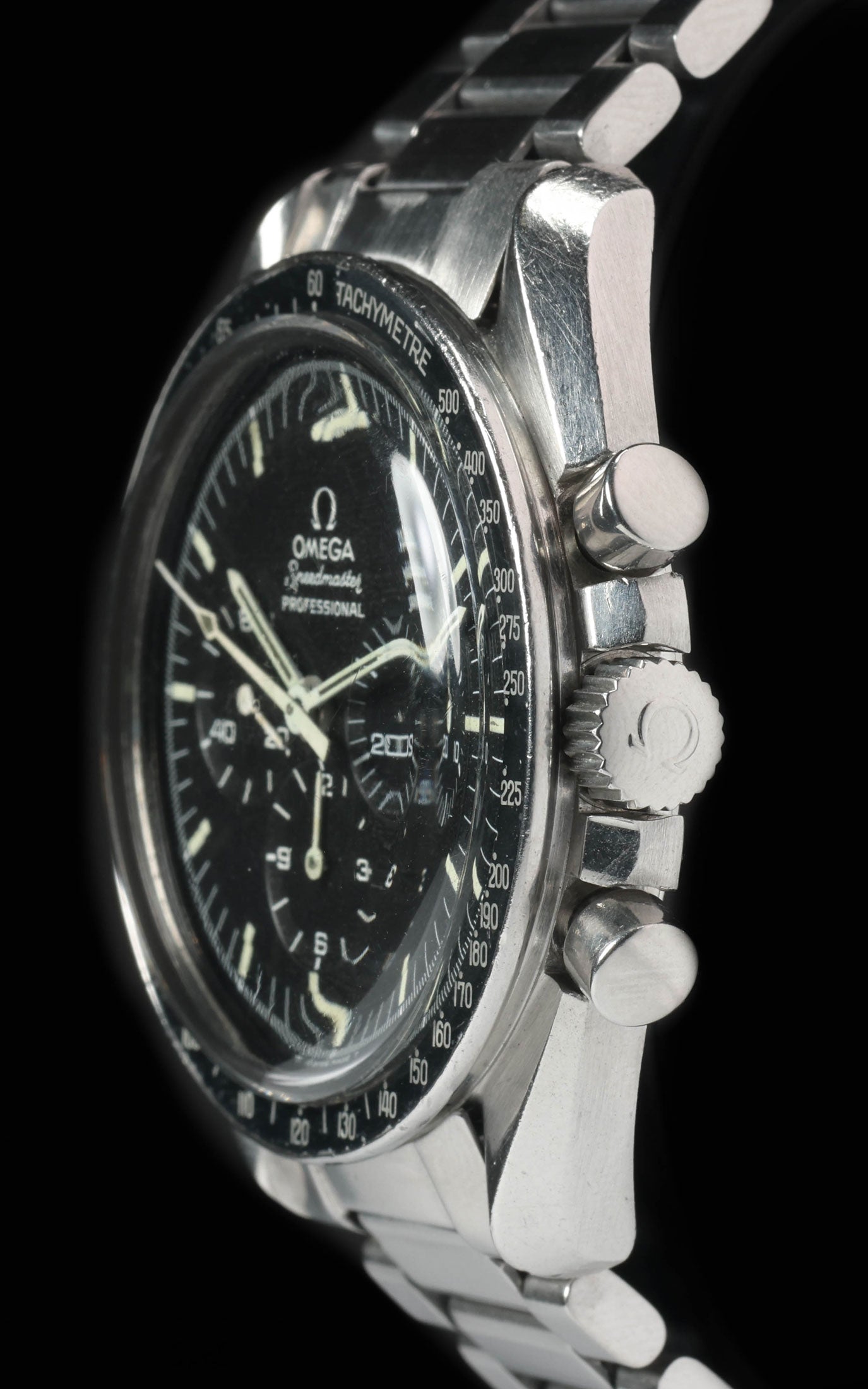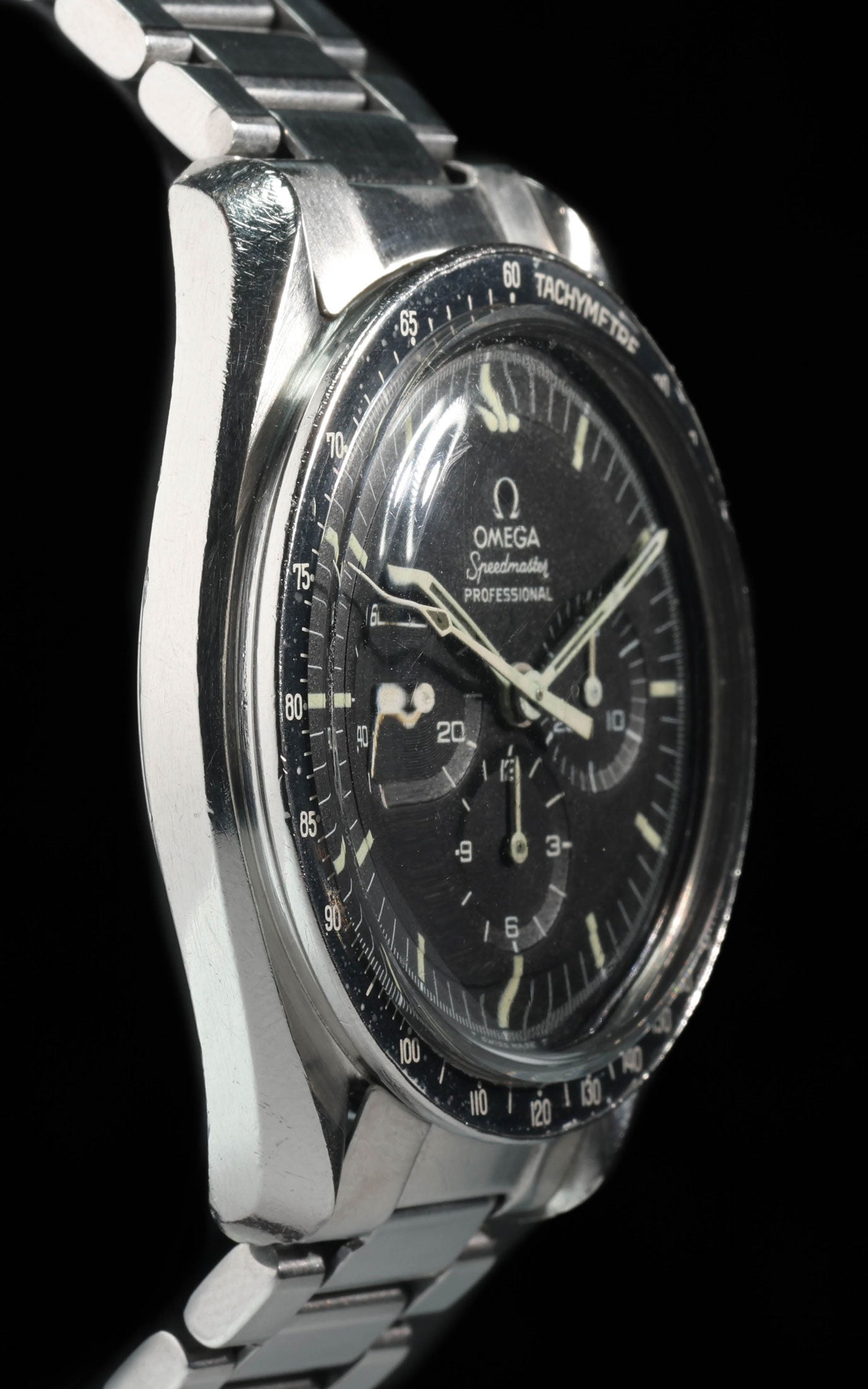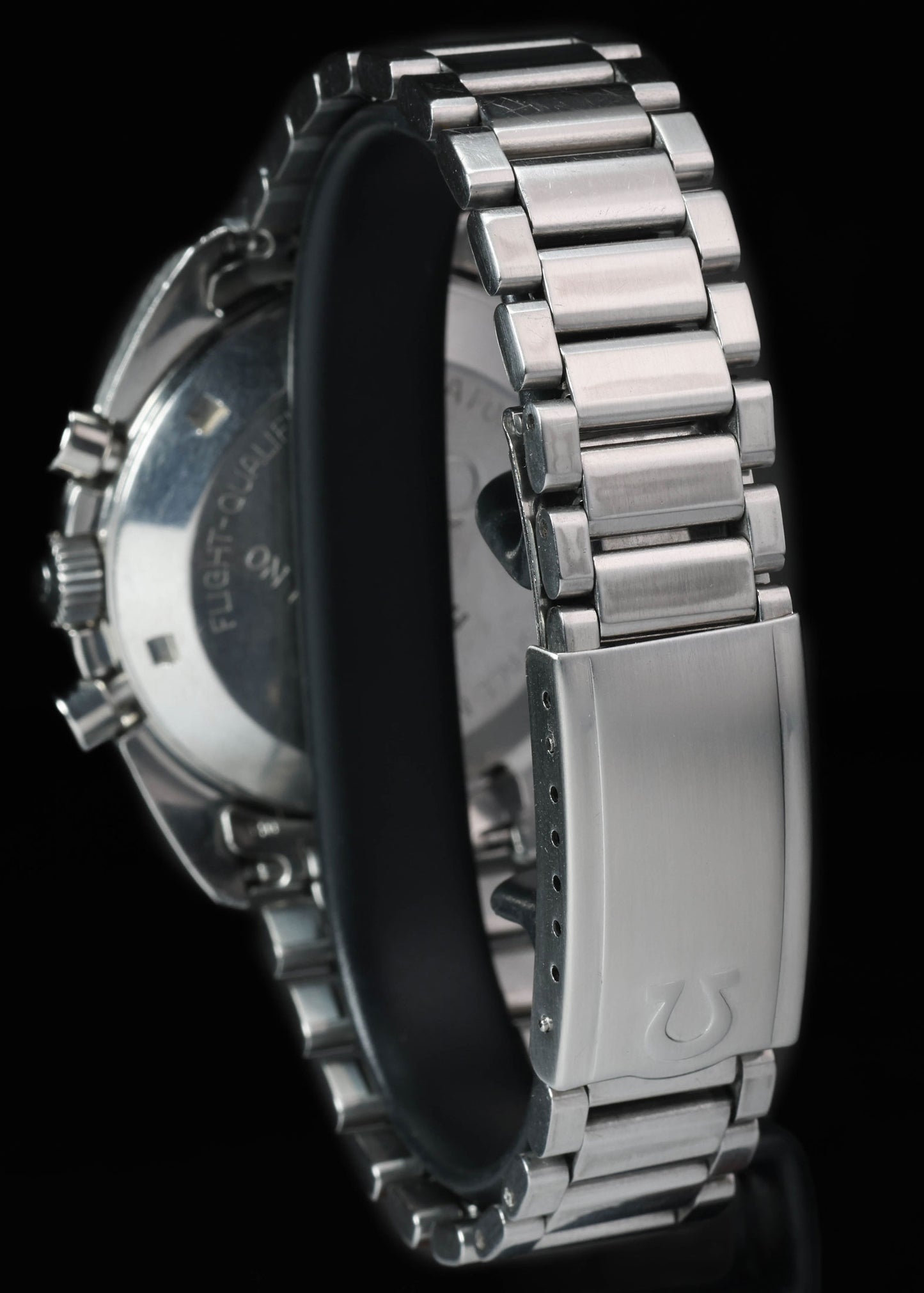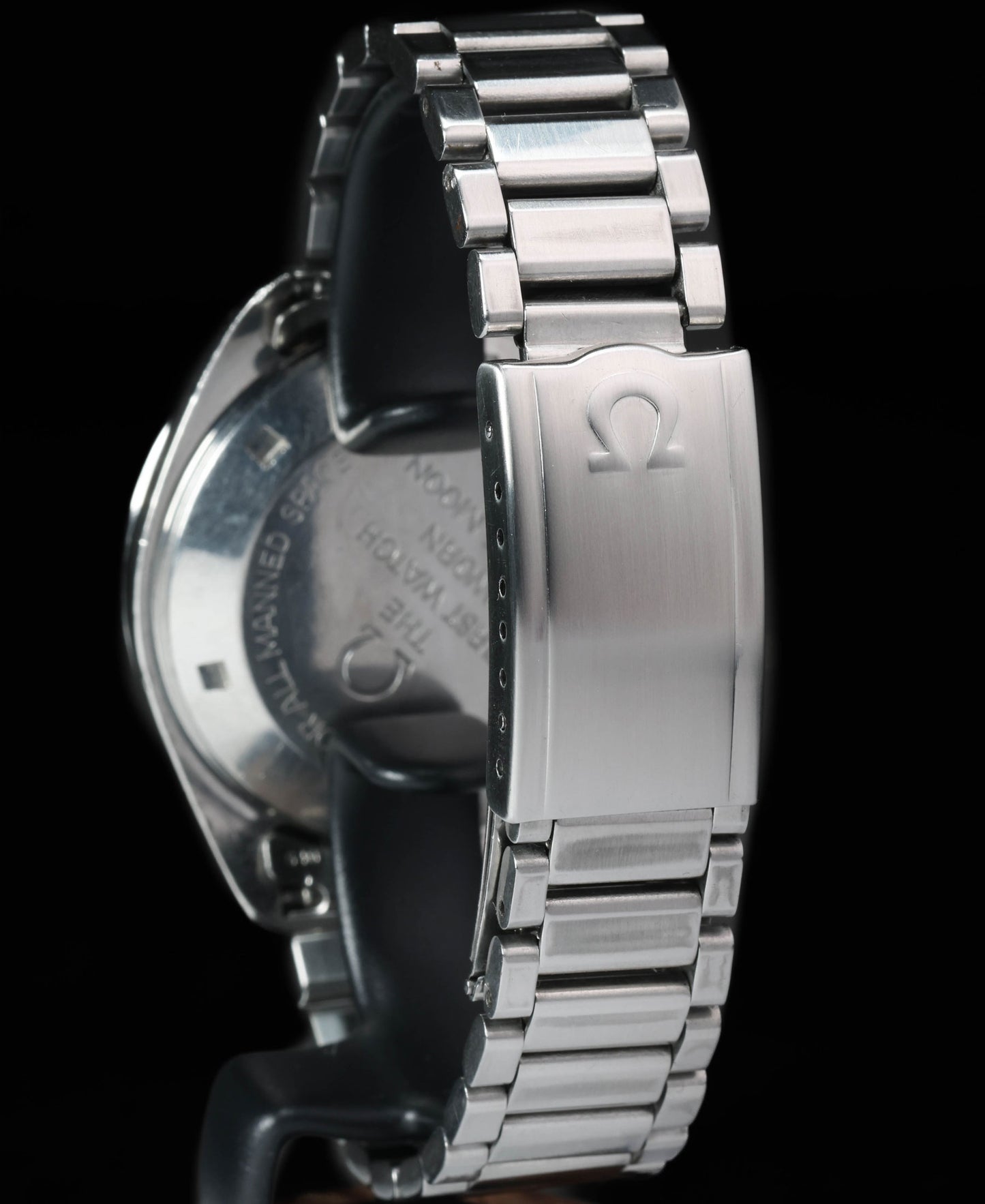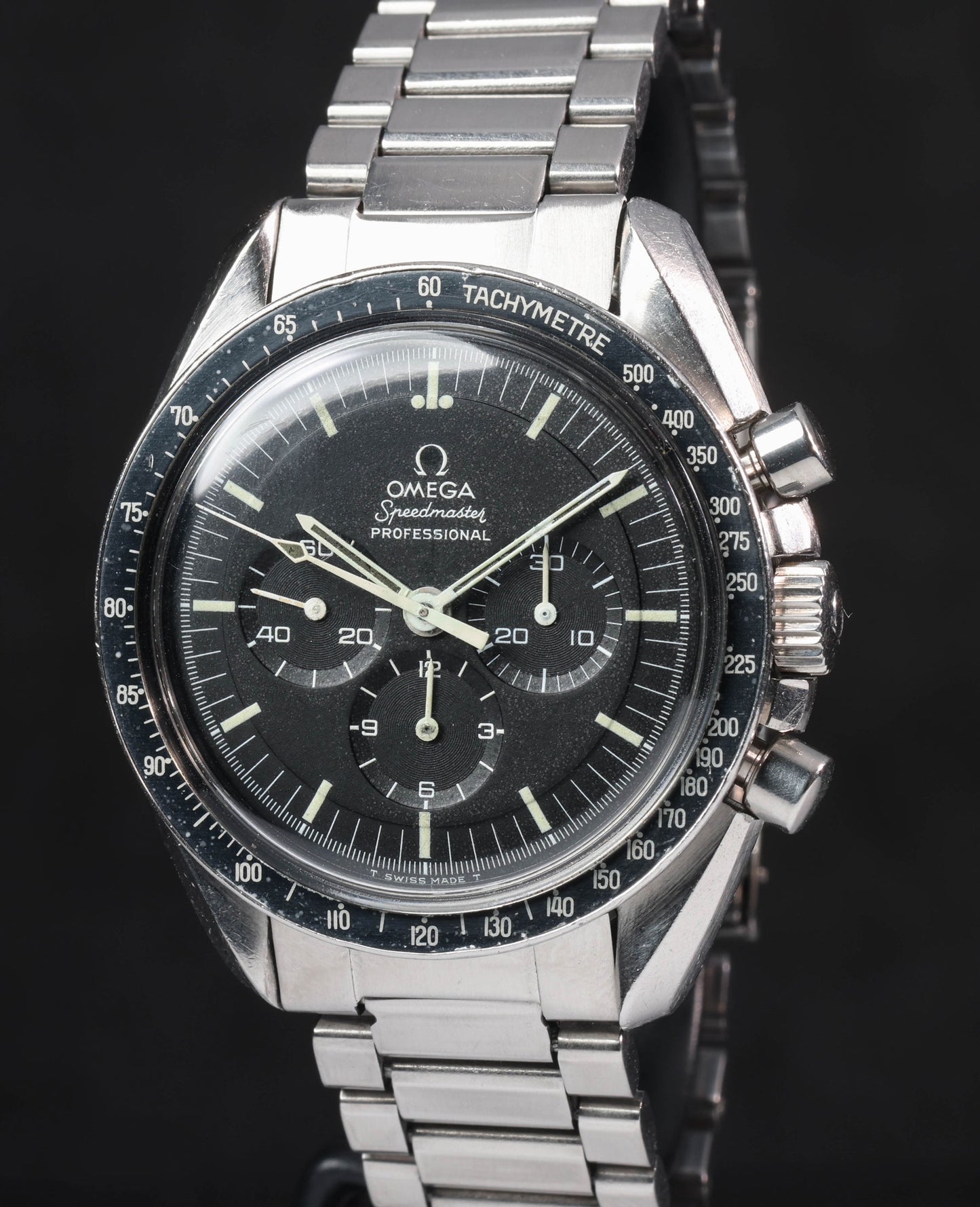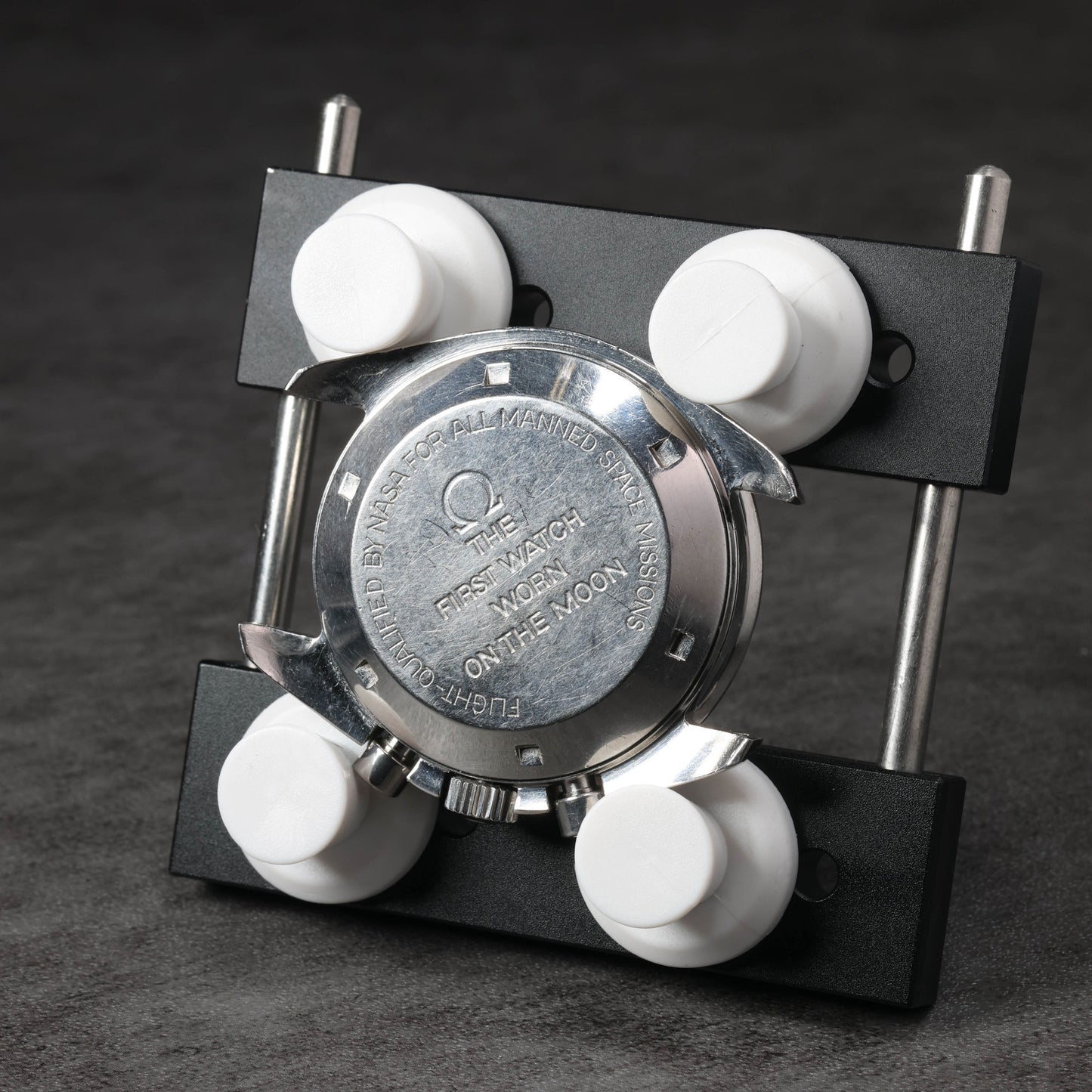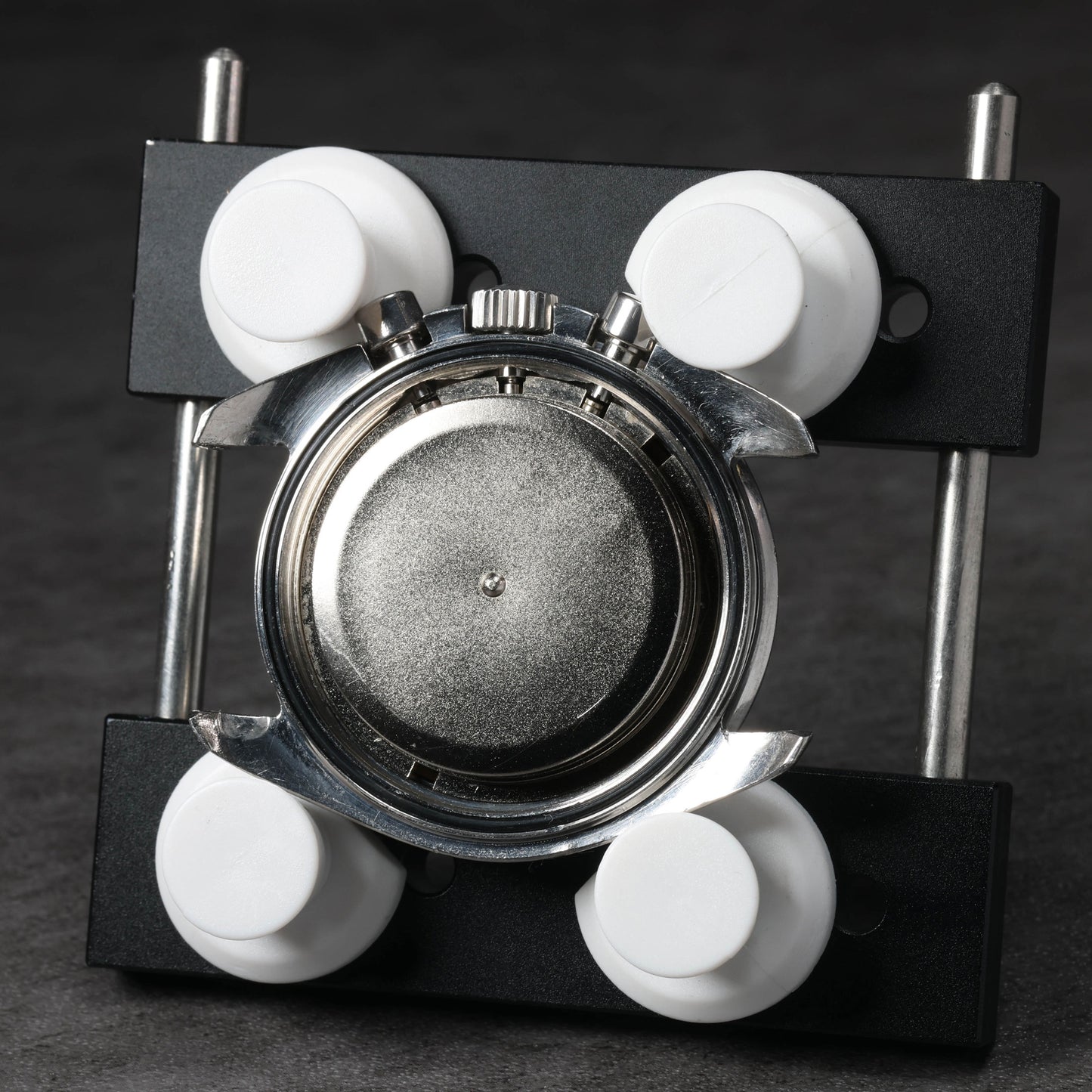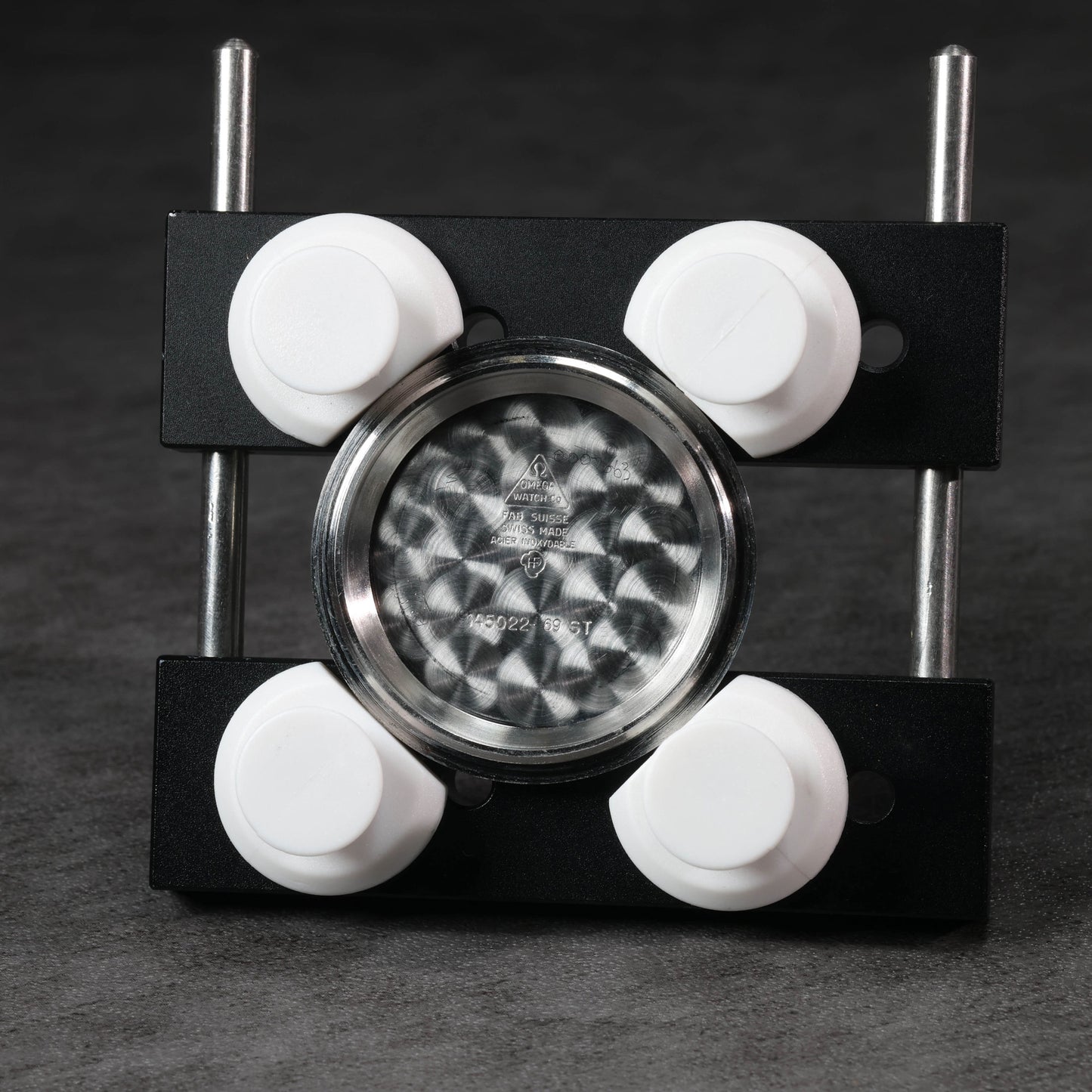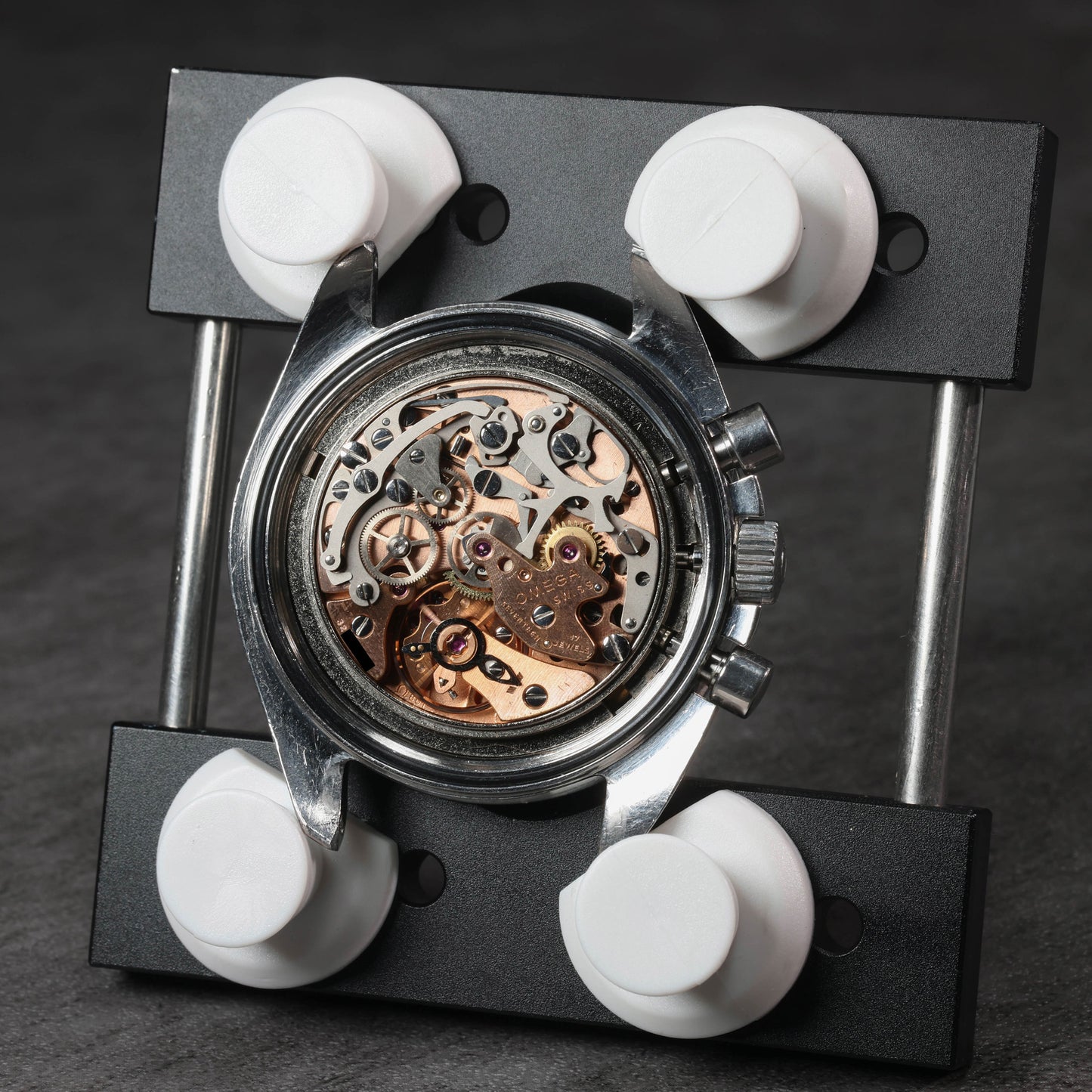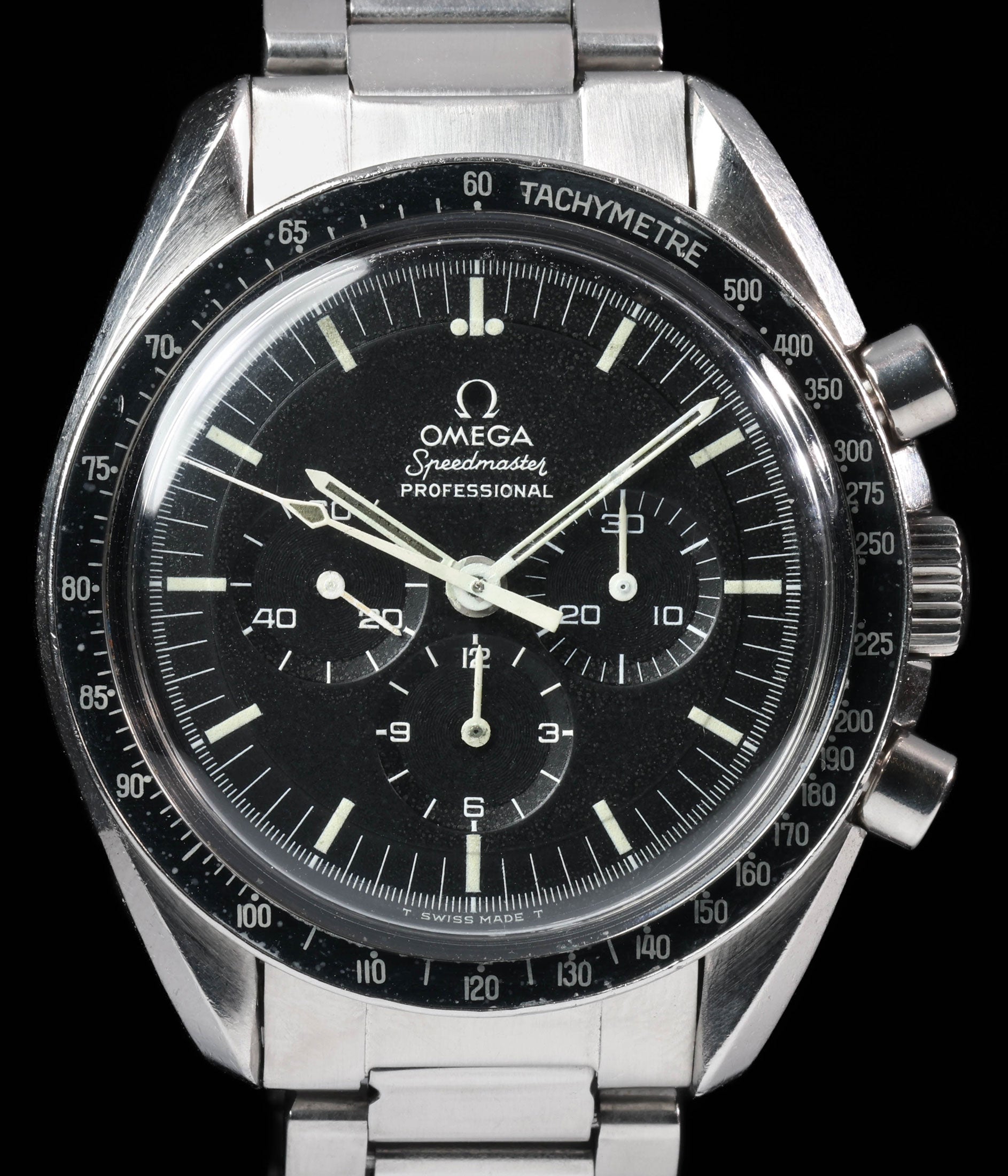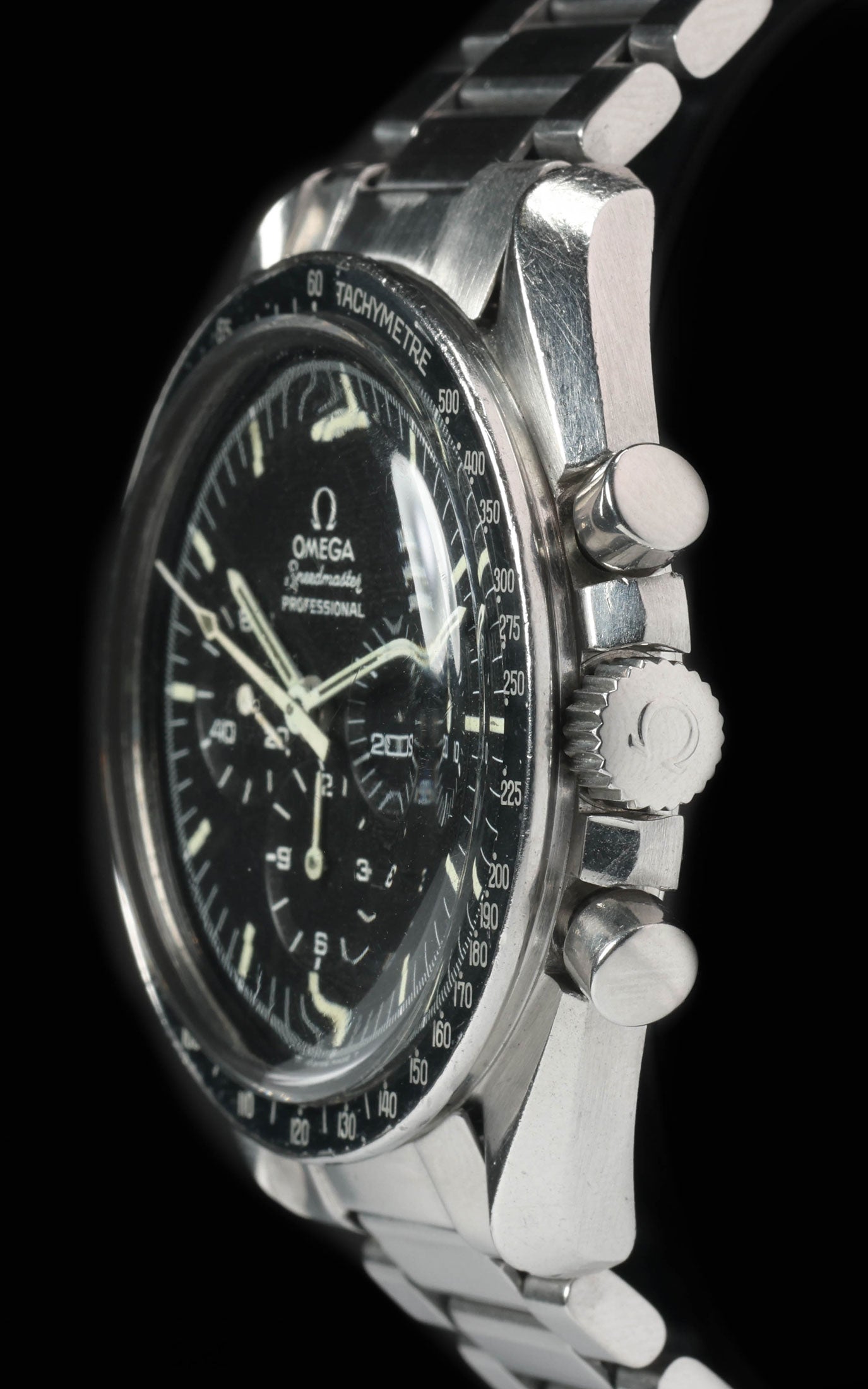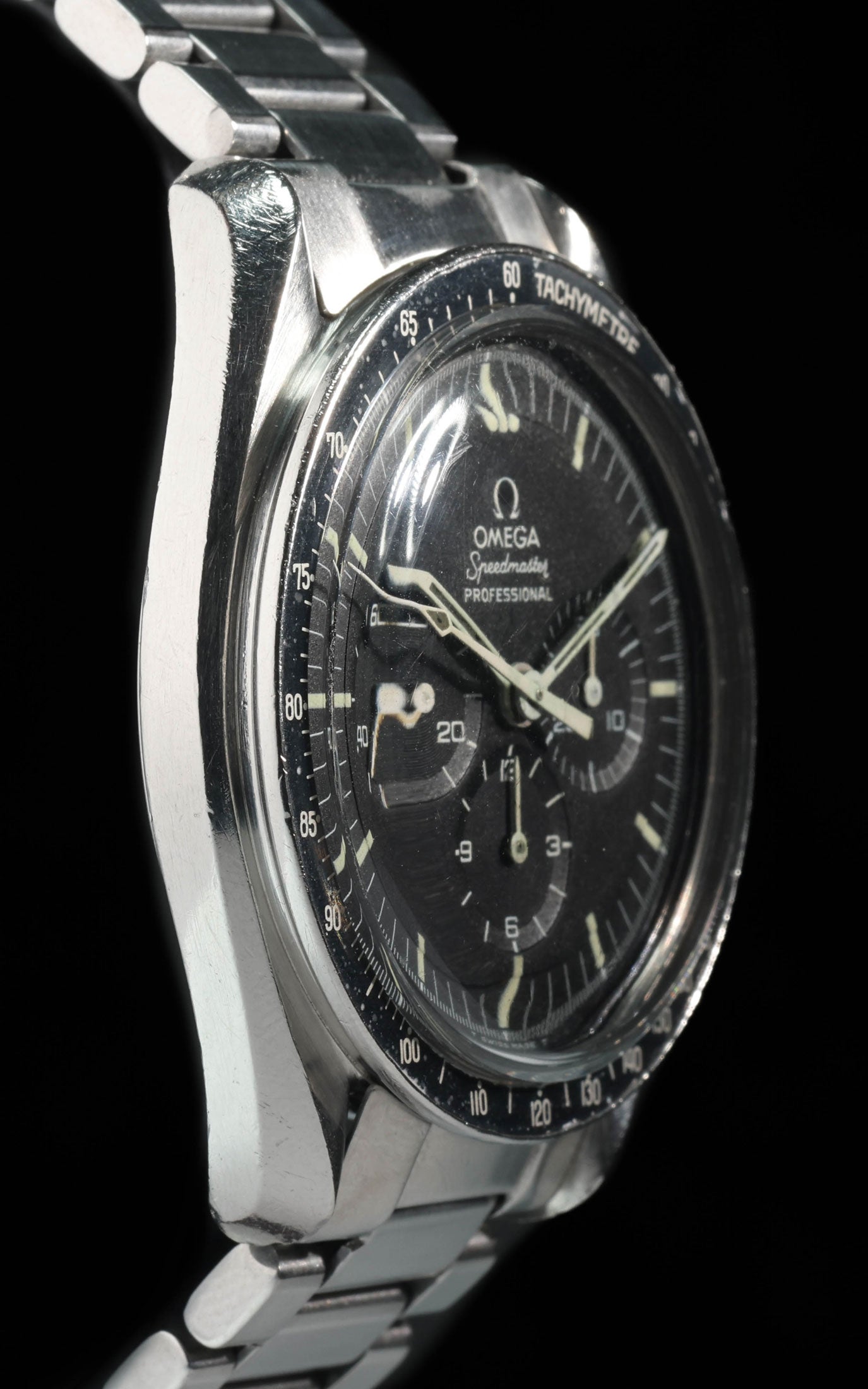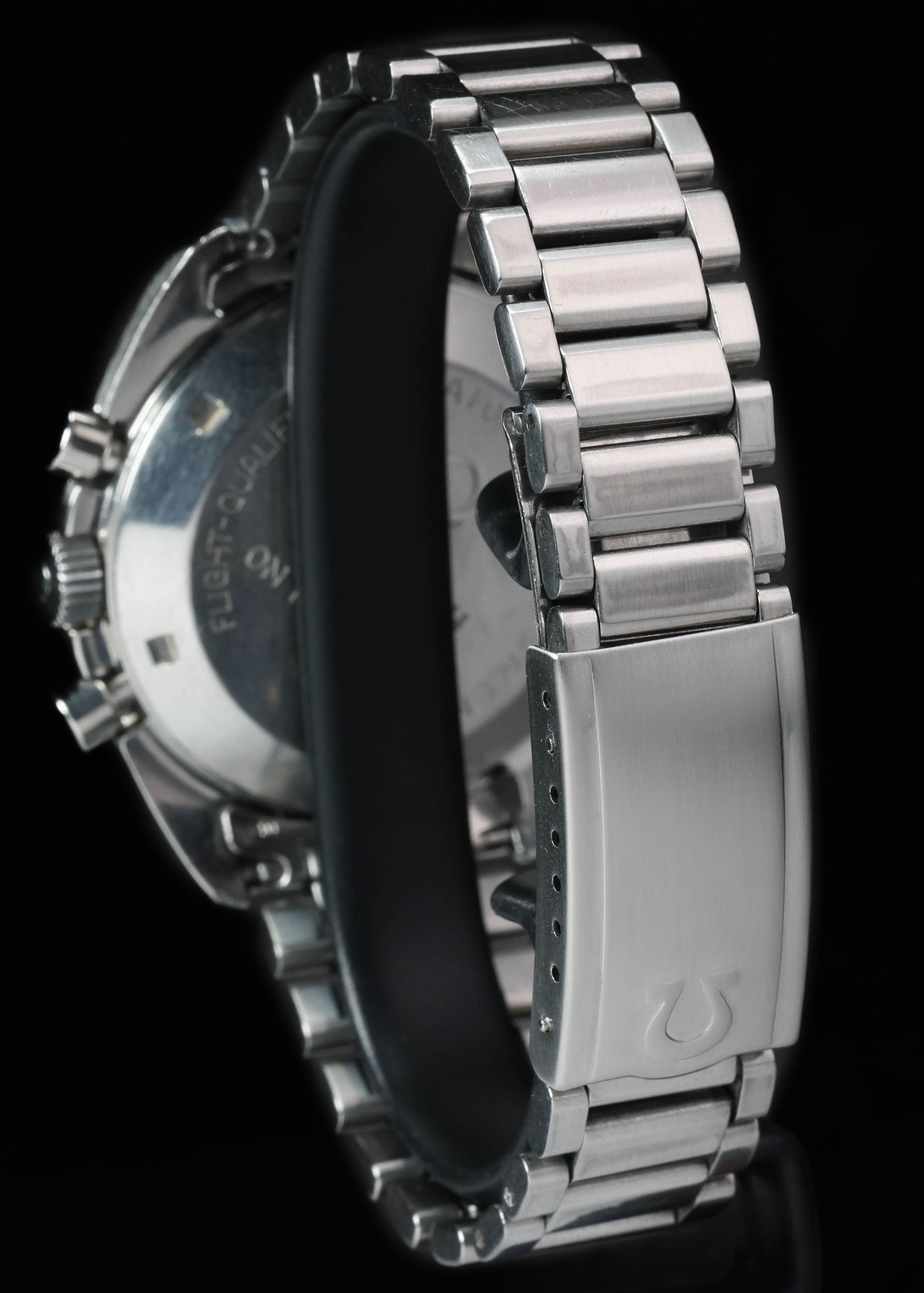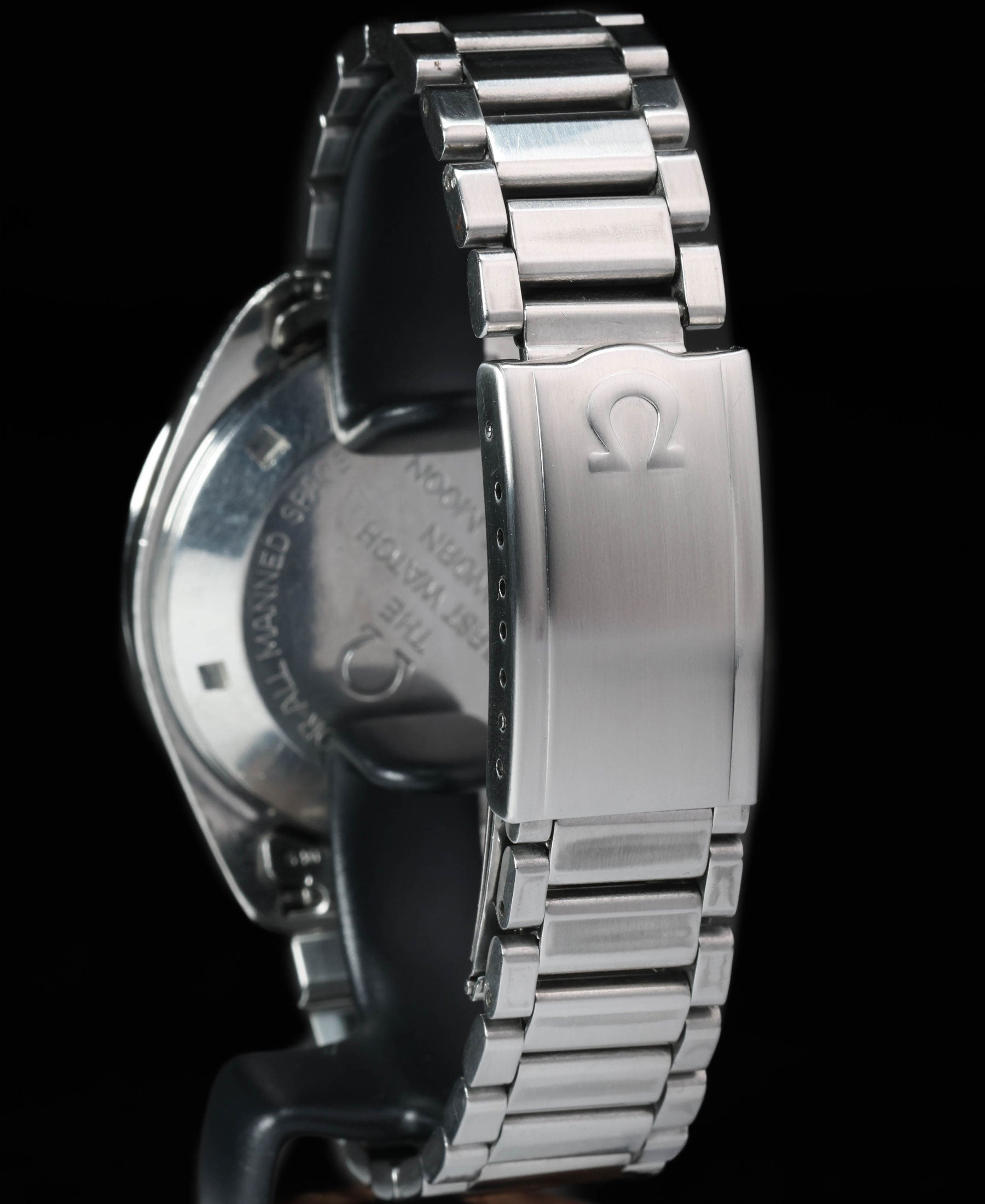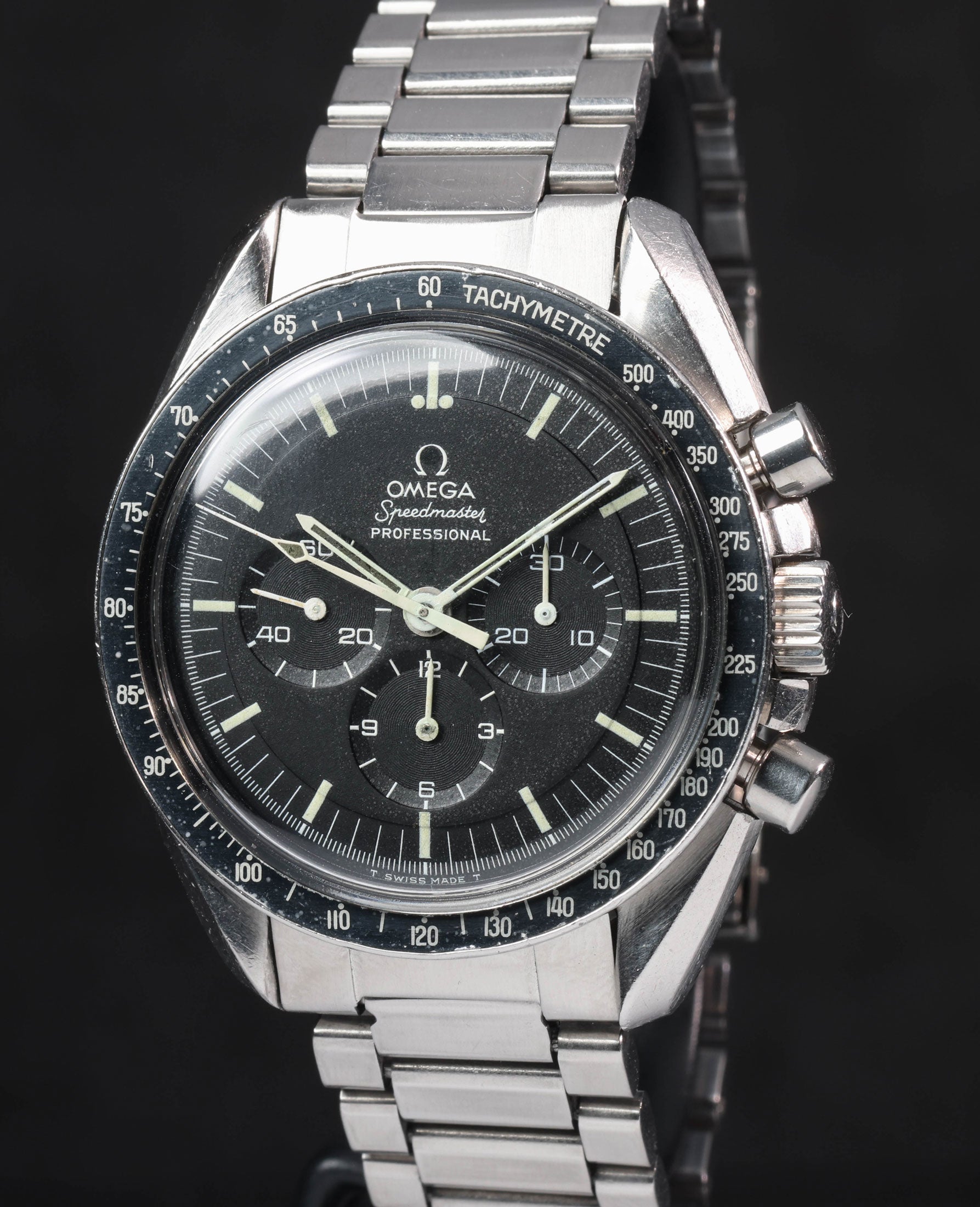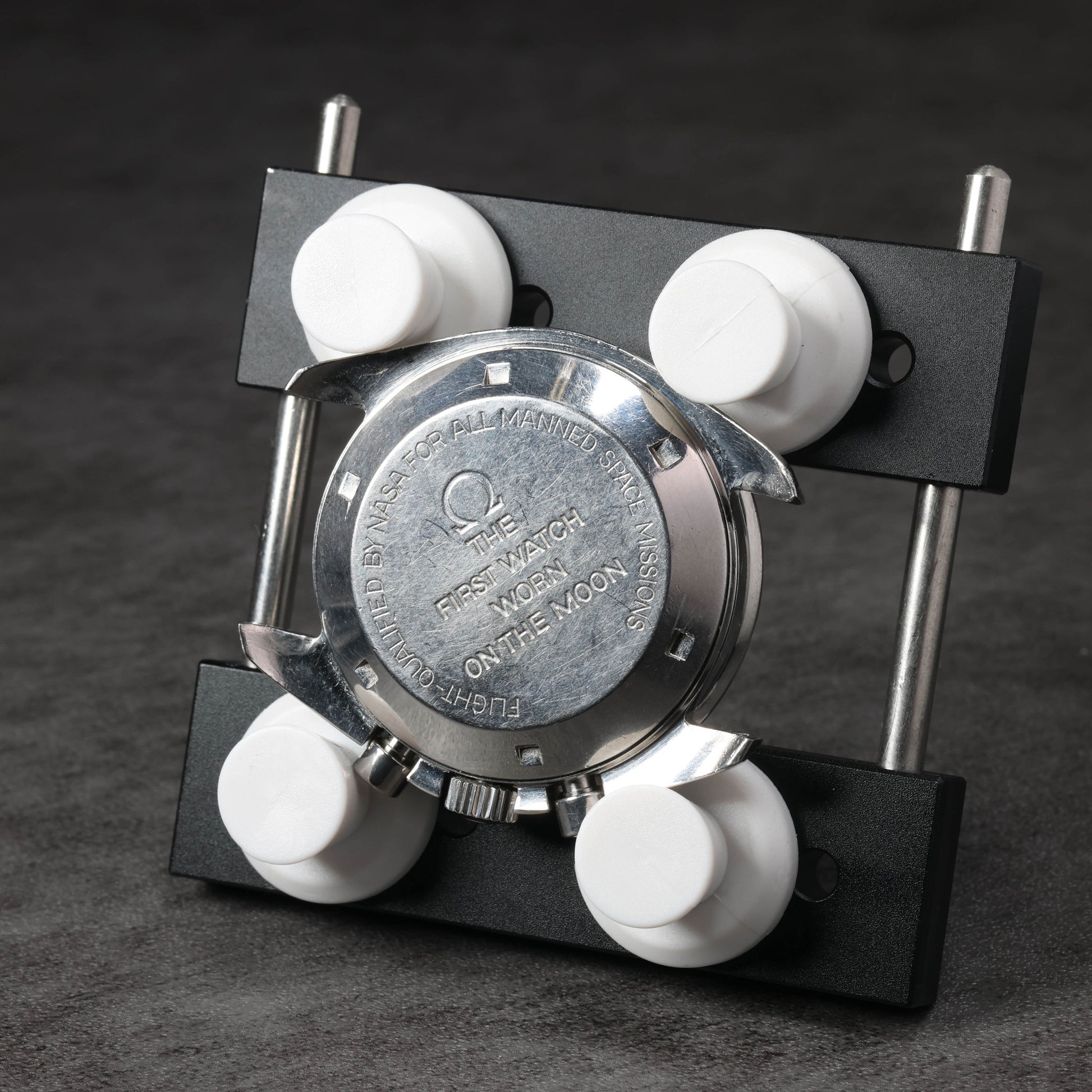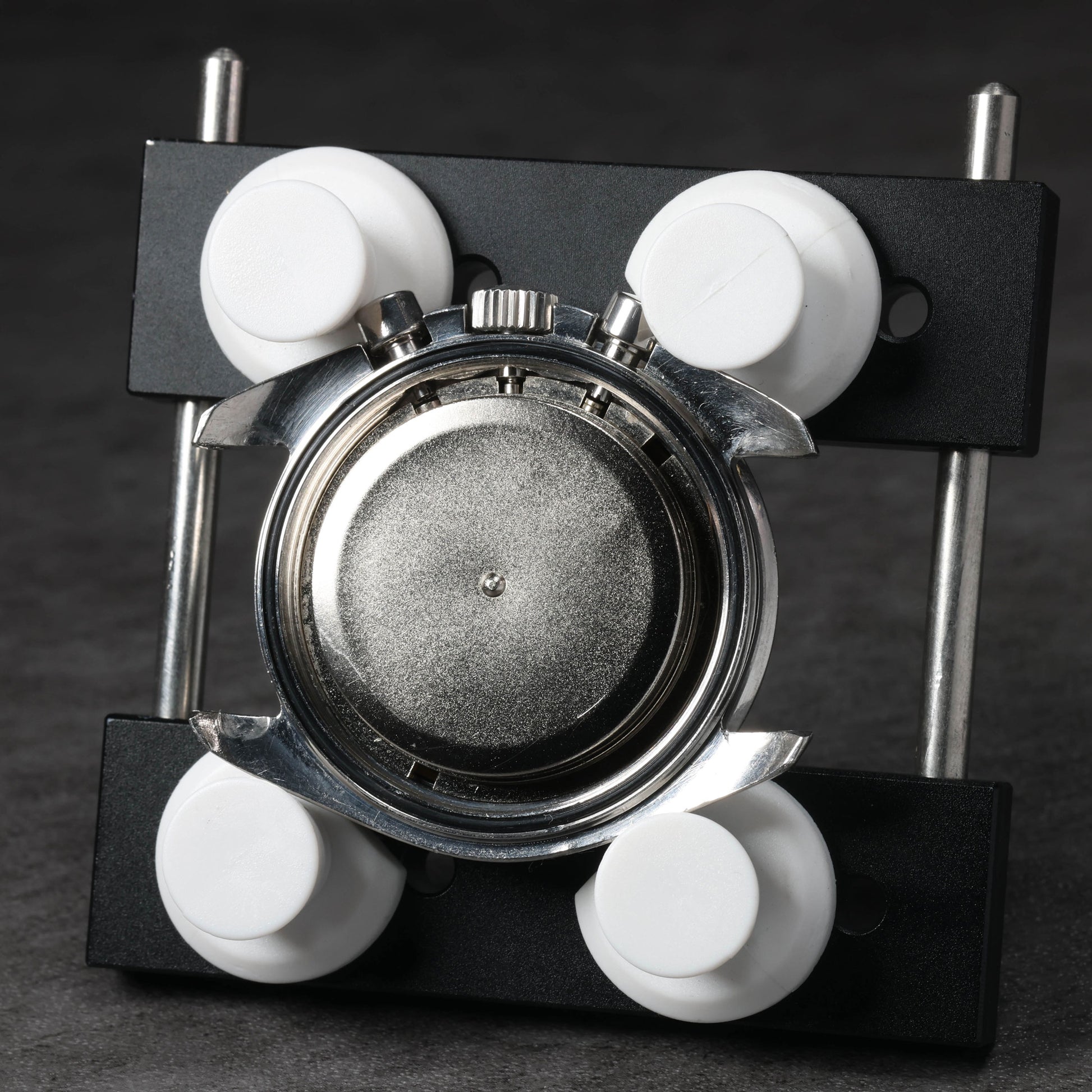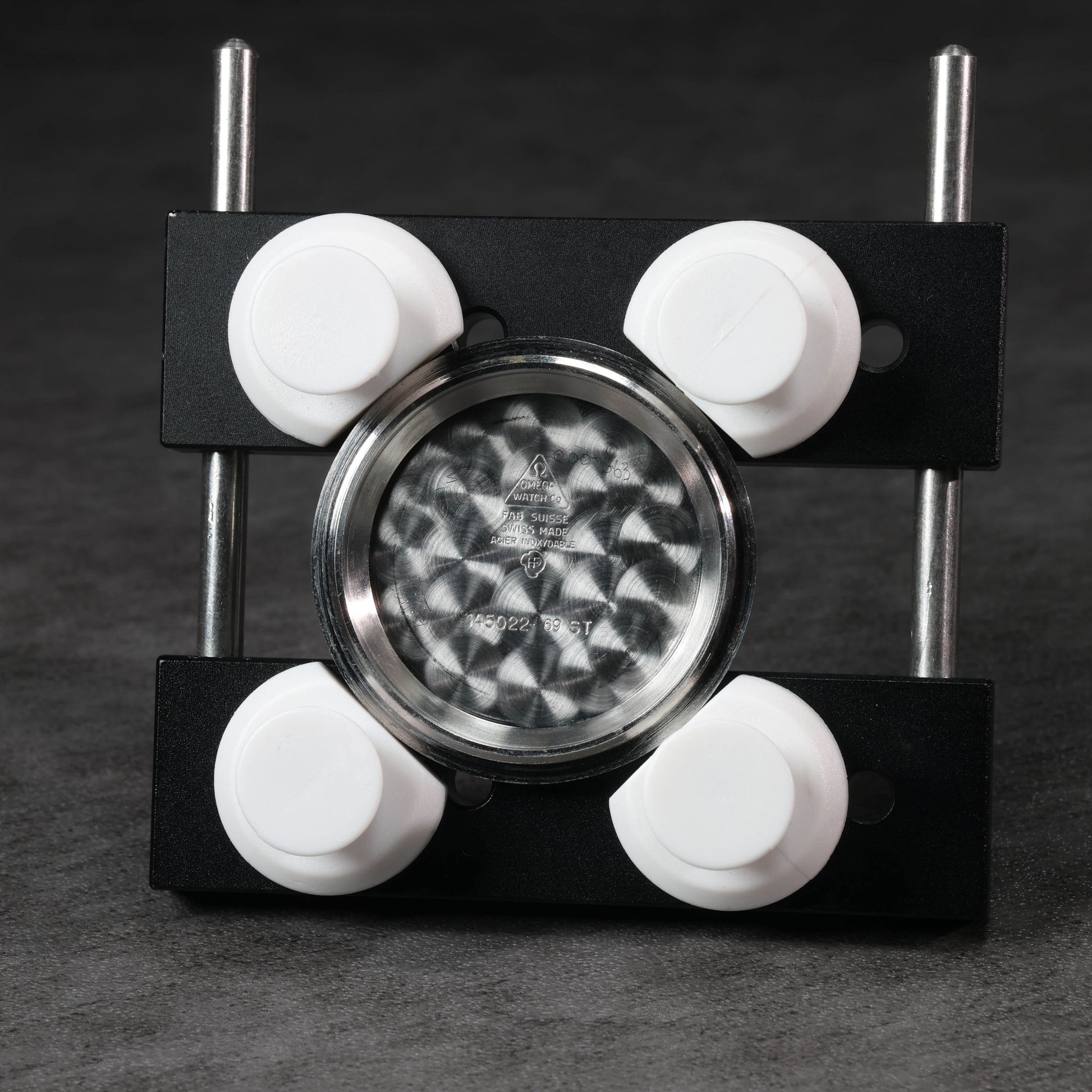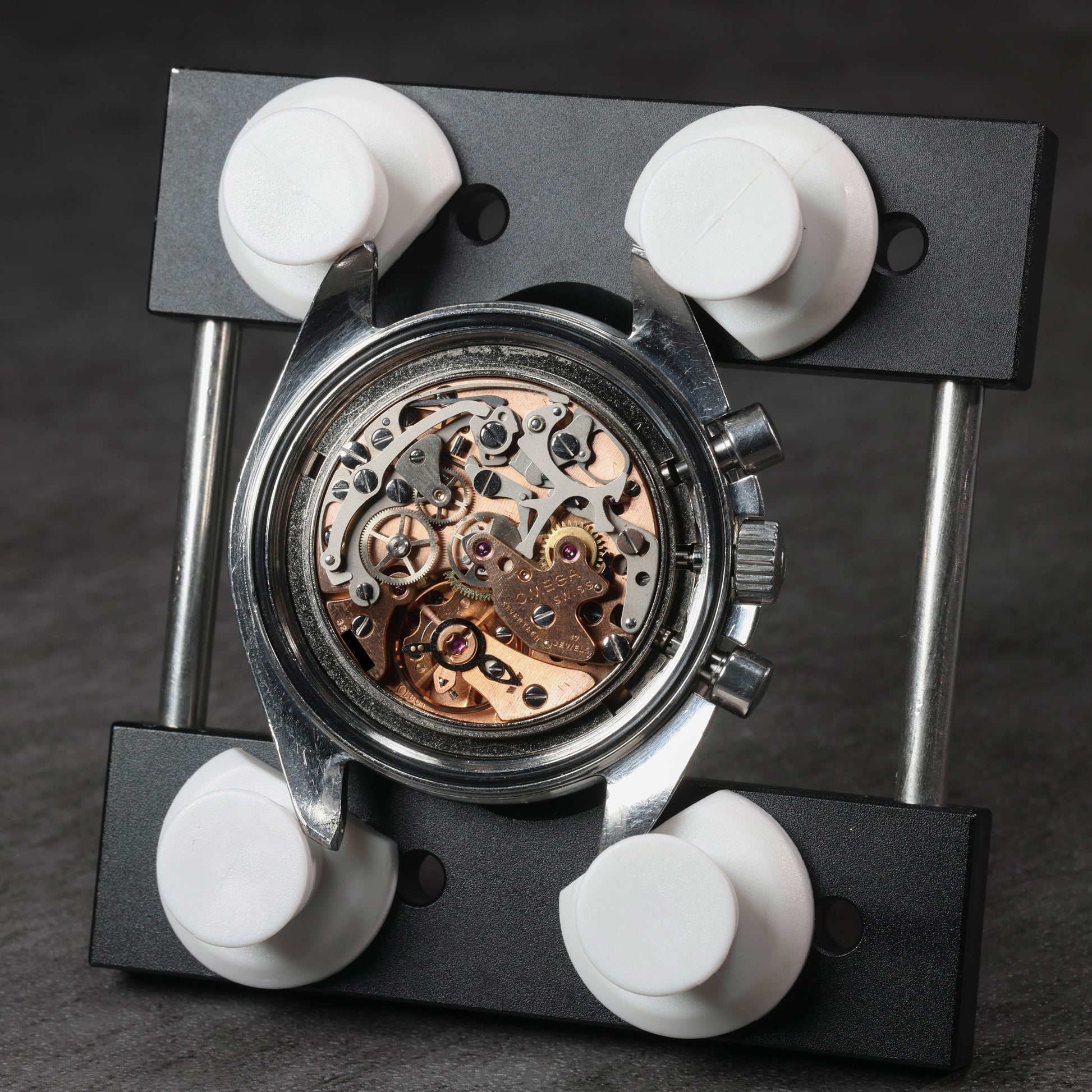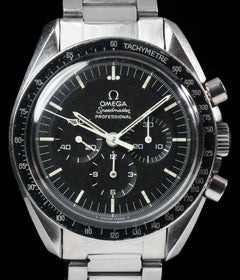Crown Vintage
Omega Speedmaster Professional 'Straight Writing' 145.022-69ST 42mm Circa 1970
Omega Speedmaster Professional 'Straight Writing' 145.022-69ST 42mm Circa 1970
Couldn't load pickup availability
Omega Speedmaster Professional 'Straight Writing'
This Omega Speedmaster Professional 145.022-69ST presents in good vintage condition throughout. The case shows age-appropriate hairlines, with lugs remaining sharp and factory brushing still clearly visible—indicative of a well-preserved example. The flat link bracelet with 1175 clasp is also in good vintage condition, showing light wear and some stretch, consistent with age. The step dial and hands are in excellent condition, displaying a pleasing and even patina that enhances the watch’s vintage character. Mechanically, the watch is running well at +10 seconds per day with strong amplitude, reflecting a healthy movement. As this piece is over 50 years old, it should be treated as a vintage timepiece and not worn while swimming—even though it was originally built for professional use.
Share
Why we love this watch
Why we love this watch
Omega Speedmaster Professional ‘Straight Writing’ 145.022-69ST: A Transitional Icon
Introduction
Among the many references in the Omega Speedmaster lineage, the 145.022-69ST with the rare “straight writing” caseback holds a distinct place. Produced during a transformative era for the Speedmaster, this model embodies both continuity and evolution—bridging the gap between the earlier pre-Moon Speedmasters and those issued in the wake of NASA’s Apollo missions. With its unique caseback engraving, step dial, and period-correct flat link bracelet, it remains one of the most desirable transitional Speedmasters among those who value historical significance, understated detail, and authentic vintage character.
The Historical Context
The Speedmaster was never originally intended to go to the Moon. Released in 1957, the Omega Speedmaster was marketed as a chronograph for motorsport professionals. The clean dial layout, robust case, and external tachymeter bezel were designed for timing laps and high-speed performance, not lunar landings. But fate had other plans.
In the early 1960s, NASA began a series of exhaustive tests to determine which chronograph could withstand the rigours of space. High and low temperature extremes, shocks, vibrations, vacuum, humidity, and acceleration—only one watch survived: the Omega Speedmaster. The reference worn during the Apollo 11 Moon landing in 1969 was the 105.012, and it was this success that pushed Omega to embrace the “Moonwatch” identity.
The 145.022 reference was introduced in 1968, replacing the legendary calibre 321 with the new, cam-operated calibre 861. The sub-reference 145.022-69ST continued this lineage and became the first Speedmaster reference marketed in a post-Moon landing world. Omega began including engraved casebacks that referenced this lunar achievement, and for a short time, one version stood apart: the “straight writing” caseback.
This watch reflects an interesting transitional moment—not just in technical execution, but in how Omega was repositioning the Speedmaster. It was no longer simply a professional chronograph—it was now the watch worn on the Moon, and marketing followed accordingly. Yet the straight writing variant feels almost modest in its branding compared to what followed. It carries the weight of history without overstatement, and that makes it all the more appealing to those drawn to authenticity.
The ‘Straight Writing’ Caseback
Most Speedmaster casebacks before this period featured the Omega Seahorse or Hippocampus emblem without any Moon reference. But during a brief production window, Omega introduced a caseback engraved simply with: “THE FIRST WATCH WORN ON THE MOON.” This was executed in a clean, linear style—hence the nickname “straight writing.”
Unlike the later radial casebacks, which featured more elaborate layouts, the straight writing version is minimal and businesslike. It feels less like a marketing tool and more like a commemorative engraving—proud, but understated. These casebacks were only used for a short time and were eventually replaced by the radial text versions that became standard in the 1970s and beyond.
The straight writing caseback was manufactured between roughly late 1970-1972, though it appears on watches with -69 casebacks due to Omega’s practice of continuing reference numbers through overlapping production. As a result, the straight writing 145.022-69ST occupies a tight window of production, making correct examples increasingly hard to find today.
The Step Dial: Subtle Dimensionality
The dial on this reference features one of the most beloved Speedmaster details—the “step dial.” This is a matte black tritium dial with a distinctive recessed chapter ring around the outer edge, creating a stepped effect that adds depth and structure. It’s a detail that helps distinguish early 861-powered models from later variants.
Importantly, this dial carries a printed Omega logo—not an applied one, as found on earlier references such as the 105.003 or 105.012. This distinction is critical for authenticity. The white printed logo sits just below 12 o’clock, followed by the classic “Speedmaster” and “Professional” text in white.
Tritium lume plots are applied at each hour marker and typically age into a soft custard or creamy hue over time. The subdials at 3, 6, and 9 o’clock are deeply recessed and provide excellent visual balance. The overall effect is that of a professional-grade instrument with just enough dimensional interest to reward close inspection.
The Calibre 861 Movement
Powering the 145.022-69ST is the calibre 861, Omega’s replacement for the earlier calibre 321. Developed by Lemania, this hand-wound, cam-actuated chronograph movement is more robust and easier to service than its predecessor. It operates at 21,600 vibrations per hour and features a more modern construction with fewer delicate components.
While the 321 is widely revered for its column wheel and silky pusher feel, the 861 delivered better reliability—especially under the extreme conditions of space travel. Omega’s decision to transition to the 861 was one of practicality, ensuring astronauts and customers alike could count on the Speedmaster to perform without compromise.
The calibre 861 would power the Speedmaster for decades, remaining in production until the calibre 1861 was introduced in the late 1990s. It is a movement that helped carry the Speedmaster legacy from the Apollo era into the modern day.
Flat Link Bracelet with 1175 Clasp
This watch is fitted with the correct flat link bracelet, a lightweight and supple design typical of Omega’s tool watches during this era. The flat link bracelet is made up of folded steel components, offering flexibility and comfort while maintaining a subtle visual profile.
What makes this bracelet especially noteworthy is the presence of the 1175 clasp. Less common than the more frequently seen 1171 clasp, the 1175 represents a short-lived production variant that adds a layer of period-correct charm. The bracelet tapers gently and sits flush against the case’s twisted lugs—providing both aesthetic harmony and comfortable wrist presence.
Over the years, many Speedmasters have lost their original bracelets due to wear, damage, or service replacements. As such, the survival of the correct 1175 clasp and flat link bracelet on this example elevates its collectability significantly.
Dot Over 90 Bezel Variants
One detail that Speedmaster collectors often obsess over is the bezel. Early Speedmasters came fitted with tachymeter bezels where the dot (or marker) sits directly above the 90 on the scale—these are referred to as “DON” or Dot Over Ninety bezels.
This detail was gradually phased out in favour of DNN (Dot Next to Ninety) bezels during the early 70s. Due to Omega’s overlap in production and assembly practices, some straight writing 145.022-69ST examples were delivered with DON bezels, especially early ones. However, not all watches from this period retained them, and many were replaced during service.
The particular watch discussed here does not feature a DON bezel. Instead, it has the later DNN variant, which is correct for its production timeframe. While some collectors may prize the DON for its scarcity, what matters most is originality and consistency within the watch’s broader configuration.
The Asymmetrical Case
The 42mm asymmetrical case introduced in the 105.012 continues here, with its signature twisted lugs and integrated crown guards. This design balances visual boldness with real-world functionality—protecting the crown and pushers from impact while creating an elegant profile on the wrist.
Brushed finishing along the case sides and polished facets along the lugs offer visual contrast and catch light beautifully. The hesalite crystal, used on all Moon-era Speedmasters, is warm and easily recognisable by its slight distortion at extreme angles.
Despite its tool-watch heritage, the case design feels refined. It’s one of the key reasons the Speedmaster remains so versatile today—looking at home on the Moon, on racetracks, or under the cuff of a jacket.
Rarity and Collectability
This particular configuration of the Speedmaster Professional—straight writing caseback, step dial, flat link bracelet with 1175 clasp, 640 end links—is increasingly rare. The short production window for the straight writing caseback and the gradual disappearance of step dials and flat link bracelets make surviving examples something of a collector’s dream.
Final Thoughts
The Omega Speedmaster Professional 145.022-69ST with straight writing caseback captures a fleeting moment in Omega’s Moonwatch history. It blends technical innovation, transitional design, and commemorative detail into one reference. With its calibre 861 movement, step dial, and flat link bracelet, it delivers all the charm of earlier Speedmasters while foreshadowing what would come in the decades ahead.
It’s a reference that offers both historical importance and understated appeal—an essential piece for any serious Speedmaster collection, especially in the condition that this watch is in.
Case & Bracelet
Case & Bracelet
Good vintage condition with hairlines visible on case. Lugs remain sharp and intact. Factory brushing is still visible. Bracelet in good vintage condition. Light wear and stretch visible.
Dial & Hands
Dial & Hands
Dial and hands in great condition with nice even patina forming. Watch is running well at +10 Sec/ day with strong amplitude.
Warranty & Condition
Warranty & Condition
Crown Vintage Watches provides a minimum 3-month mechanical warranty on pre-owned watches, from the date of purchase.
The warranty covers mechanical defects only.
The warranty does not cover damages such as scratches, finish, crystals, glass, straps (leather, fabric or rubber damage due to wear and tear), damage resulting from wear under conditions exceeding the watch manufacturer’s water resistance limitations, and damage due to physical and or accidental abuse.
Please note, water resistance is neither tested nor guaranteed.
Shipping and insurance costs for warranty returns to us must be covered by the customer. Returns must be shipped via traceable courier. Return shipment must be pre-paid and fully insured. Collect shipping will be refused. In case of loss or damages, the customer is liable.
Our Pledge
At Crown Vintage Watches, we stand by the authenticity of every product we sell. For added peace of mind, customers are welcome to have items independently authenticated at their own expense.
Condition
Due to the nature of vintage timepieces, all watches are sold as is. We will accurately describe the current condition and working order of all watches we sell to the best of our ability.
Shipping & Refund
Shipping & Refund
